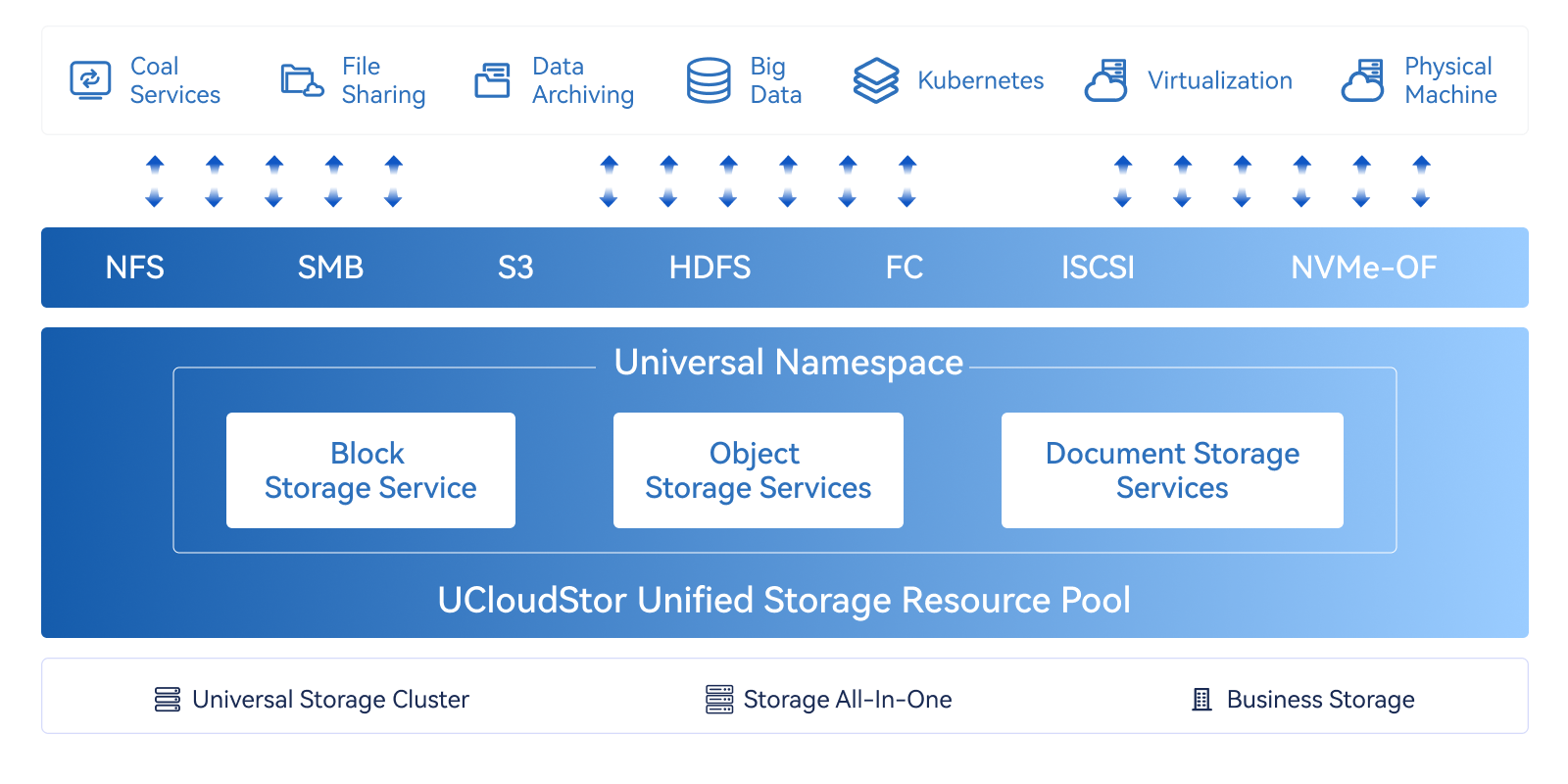Product advantage
Secure and controllable
Self-developed distributed unified storage, further reduce performance loss, core code self-developed rate of more than 97%, can provide code-level maintenance capabilities, safe, reliable and controllable
Multi-protocol data interworking
Provides NFS, SMB, S3, HDFS, FC, iSCSI, and NVMe-OF storage protocols. Unified namespace implements data interworking and multi-protocol access to the same data
Fully distributed architecture
Fully distributed architecture, all nodes and disks can independently provide storage services, all hardware and software fully redundant design, no bottleneck nodes, no single point of failure, with ultra-high availability
Comprehensive data protection
Multi-copy and erasure code redundancy, multilevel fault domain self-healing capability, improve data reliability, and provide snapshot, archive, and multi-site data disaster recovery protection, ensuring fast service recovery
Storage reuse
Heterogeneous storage resource pooling implements consolidation and unified management of existing storage resources, and provides multi-protocol data storage capabilities for upper layers, such as blocks, objects, files, and big data
Open and compatible
3-node start lightweight and flexible, capacity and performance elastic expansion, not bound to hardware and brands, compatible with X86 and ARM architecture, and can support pure soft and all-in-one delivery mode
Product architecture

Unified storage platform
A storage system provides storage services for files, objects, and blocks
File storage
Provides NFS and SMB file storage services, multi-level directory and directory tree management, and combines directory-level snapshots and fine-grained access policies to ensure file data and network access security. It also provides HDFS storage interfaces to meet data access scenarios in the big data ecosystem.
Object storage
Provides the object storage service based on standard S3 interfaces, ensures data security compliance through access control, data encryption, multi-version, WORM, token key, and log audit, supports life cycle management for data archiving, and implements data disaster recovery through multiple sites.
Block storage
Provides storage protocols, such as ISCSI, FC, and NVME-OF, to provide block storage services for virtualization and cloud platforms, thin provisioning of physical space, online capacity expansion, snapshot responses to logical data errors, and asynchronous volume replication for remote data disaster recovery.
Rich product features
Unified namespace
The unified global namespace enables interoperability among multiple protocols. The same data can be accessed using multiple storage protocols such as S3, NFS, SMB, and HDFS, building enterprise-level data lakes, clearing data islands, and simplifying data management
Multiple levels of data protection
Multi-copy and erasment-code data redundancy, multi-level fault domain topology awareness and self-healing capabilities, cross-region Dr Capabilities such as multi-site and volume replication, and disk-level anomaly detection, CRC verification, and maintenance mode capabilities.
Intelligent recovery QoS
Supports data reconstruction, recovery, and QoS rebalancing. The data restoration and migration rates can be adjusted based on the system load, preventing data read and write performance from being affected by data reconstruction and rebalancing, ensuring service I/O performance and data security.
Hierarchical hierarchical storage
Provides data lifecycle management, supports tiered storage, and automatically migrates cold data to different types of heterogeneous storage based on the time and file type. This is suitable for low-cost storage of long-term archived data.
Production-grade performance improvements
Provides SSD/NVME high-performance cache acceleration mechanism, automatic hot and cold data flow, metadata separation deployment and acceleration capabilities, optimized data and metadata performance, and provides SSD/NVME full-flash high-performance architecture.
Elastic linear expansion
The unified metadata service can be deployed separately from storage nodes. It supports horizontal online expansion of storage and metadata nodes, vertical expansion of node storage capacity, and on-demand expansion of capacity and performance based on data rebalancing.
Intelligent operation and maintenance
Unified management of multiple clusters, comprehensive management of hardware and resources, node and disk fault detection, QoS configuration restoration, comprehensive alarm monitoring, log auditing, and account rights operation and maintenance capabilities.
Seamless data migration
The built-in data migration tool supports visual data migration capabilities. Data stored in object storage and file storage on heterogeneous platforms can be imported and migrated to the platform online, and data can be automatically migrated in combination with data back source.

